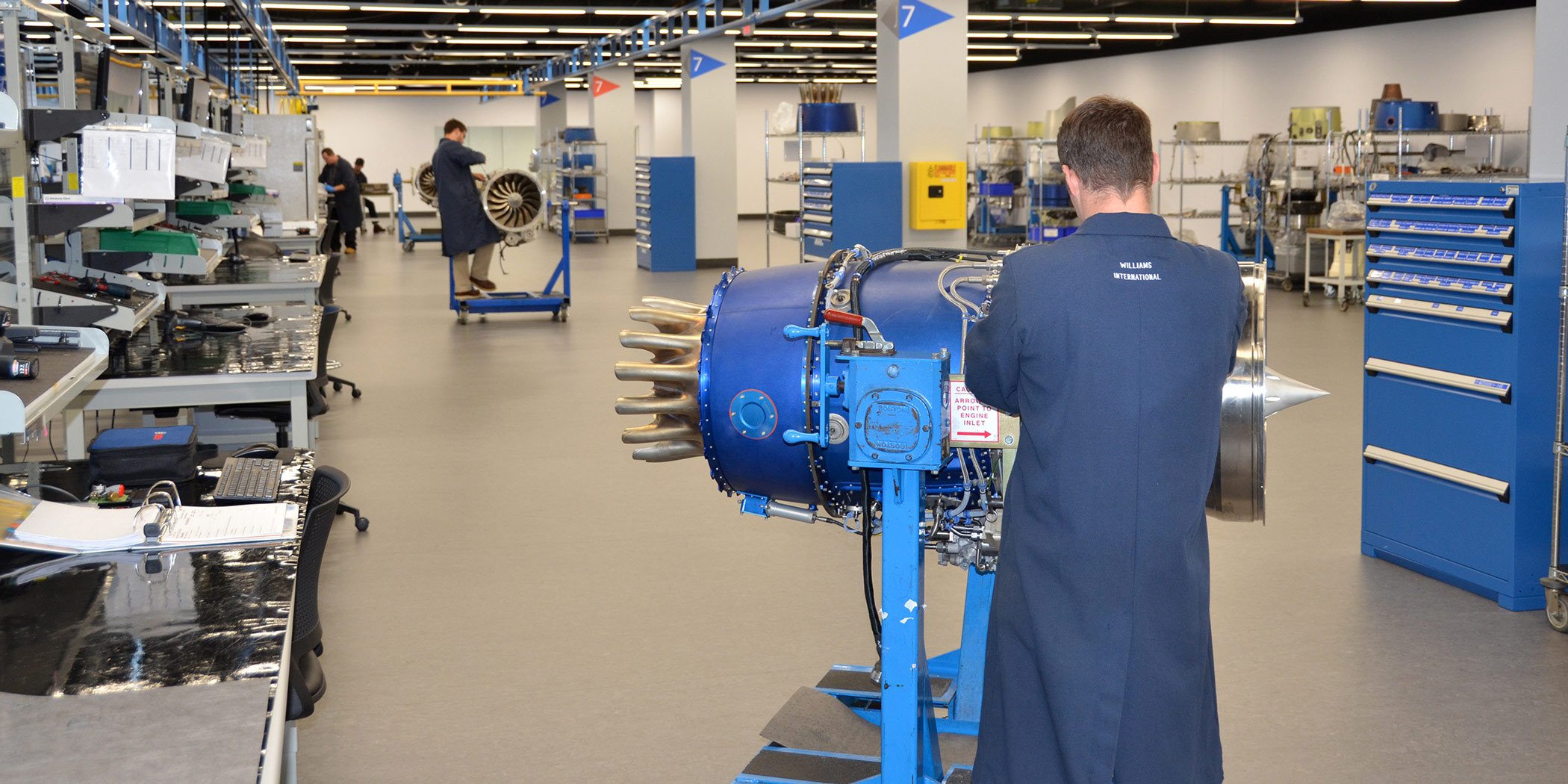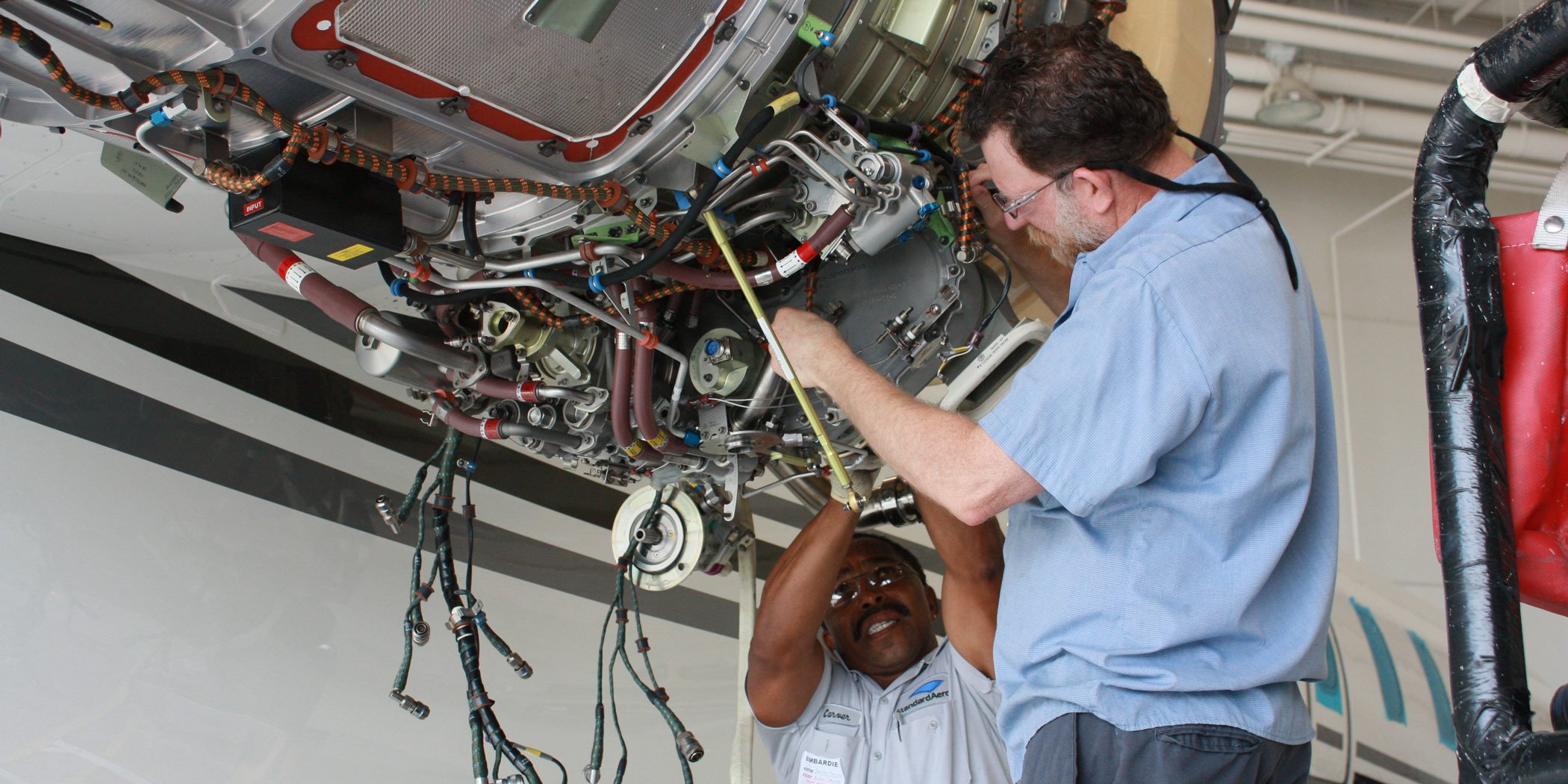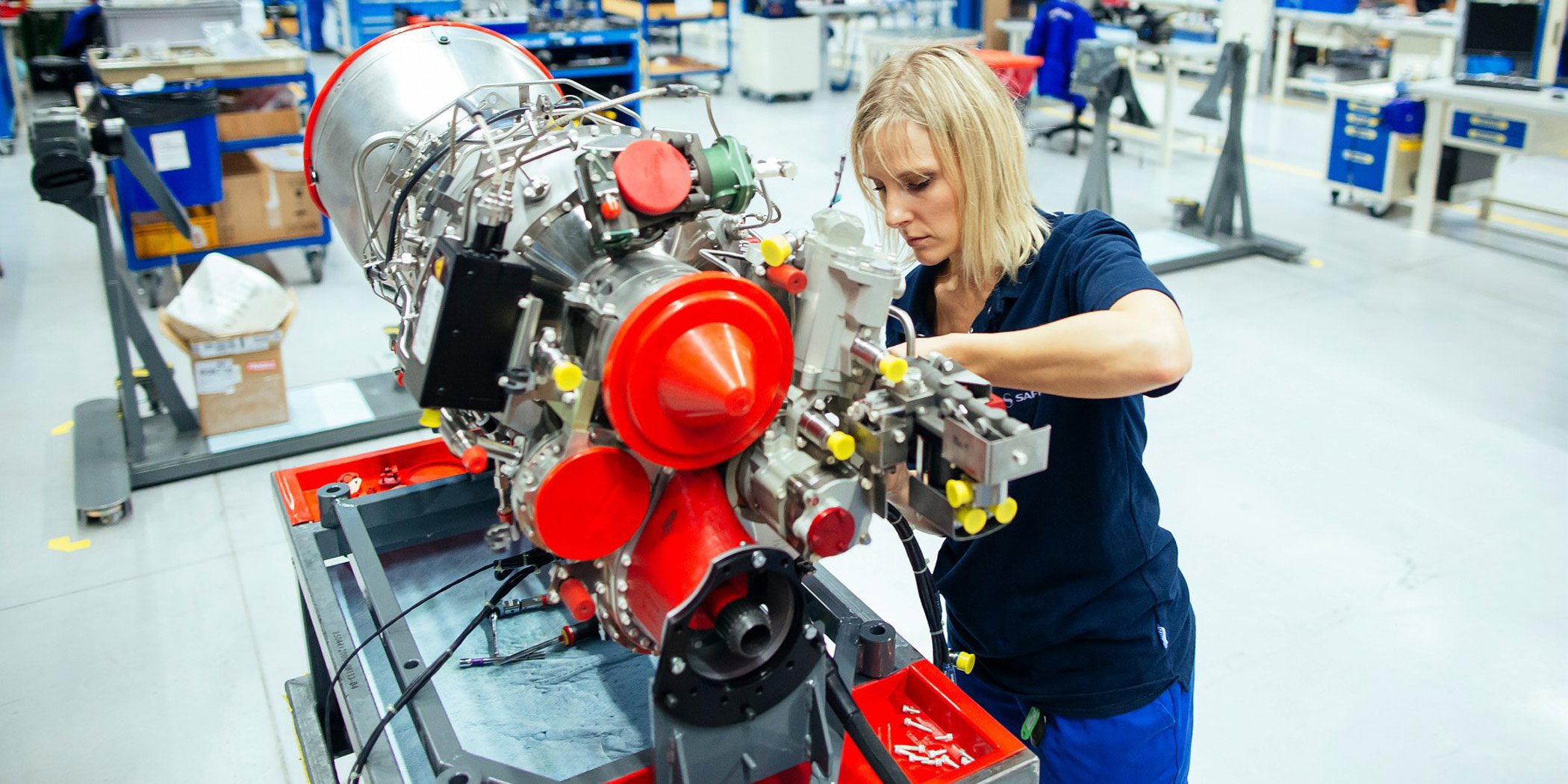Click Here to View This Page on Production Frontend
Click Here to Export Node Content
Click Here to View Printer-Friendly Version (Raw Backend)
Note: front-end display has links to styled print versions.
Content Node ID: 408502
An overall score improvement from 8.5 (out of 10) last year to 8.7 was enough to push GE Aviation to the top of this year’s AIN Engine Product Support Survey. The scores of all other OEMs fell from last year, largely a factor of covid-related supply chain and personnel problems. Honeywell appeared to take the biggest hit in this regard, with its overall score dropping from 8.2 last year to 7.6 in 2022, making it the only OEM to finish with an overall score of less than 8.0. Honeywell executives told AIN that the company is acutely aware of these issues and has embedded its personnel with key suppliers in an effort to unsnarl the bottlenecks and address related issues, including AOG times.
Williams International finished a strong second, with an overall score of 8.6, driven by top marks in the parts cost, AOG response, technical manuals, and tech rep categories. But its overall score still reflected a drop of two-tenths of a point compared to last year, when it finished first overall in the survey. GE and Williams both scored 9.0 or better when it came to the key metric of warranty fulfillment.
Not surprisingly, the cost of parts and parts availability drove down the scores of OEMs, but overall engine reliability scores remained strong for everyone, with nine out of ten engines surveyed posting reliability ratings of 9.0 or better. GE Aviation and Rolls-Royce topped that category with a reliability rating of 9.4 each, driven in large part by the continued strong performance of GE’s 8,000-strong fleet of legacy CF34 turbofans and the Rolls-Royce Tay, first introduced in 1988, that powers many legacy large cabin Gulfstreams, including the GIV.
For turboprop and turboshaft engines, Pratt & Whitney continues to dominate, with an overall score of 8.5 in each category. However, the company’s overall score for turboshaft engine support on helicopters dropped from 8.9 last year.
1. GE Aviation

GE Aviation has jet engine product offerings for small, super-medium, large-cabin, and long-range business jets including the HF120 on the HondaJet, the CFE738-1B on the first generation Dassault Falcon 2000, the CF34-3 on the Bombardier Challenger 600 series, and the Passport on the Bombardier Global 7500. The company offers enrollment product support through its OnPoint program. Melvyn Heard is the president of the company’s business aviation programs.
The Passport is the company’s newest business jet offering and is installed on more than 150 aircraft in service. Heard said that approximately 85 percent of Global 7500 customers are enrolled in OnPoint. The fleet has amassed 100,000 flight hours and 40,000 flight cycles. For all customers, the Passport is supported by a staff of 20 on a mobile repair team, that is able to deploy anywhere in the world, and an additional 20 field service representatives. Throughout GE Aviation’s business engine offerings, the company works with 45 service support partners.
GE is seeing an even higher enrollment rate, approximately 90 percent, of its HondaJet GE Honda Aero Engines HF120 customers who fly the 500 engines for that aircraft. That fleet recently surpassed the 250,000-hour flight mark. Also this year, GE is celebrating the 30th anniversary of the first delivery of its CF34 series of engines for Bombardier’s Challenger 600 series and regional jets, with more than 8,000 of those powerplants delivered since 1992.
“Coming out of covid has allowed us to be a lot more engaged with our customers, to actually get out and be with them, continue our training requirements with them, and create new tools to engage them like remote training and workshops,” Heard said.
“With the geographic restrictions that were in place through covid, we still wanted to have that engagement to keep our customers up to date with training requirements. So we came up with a new series of video webinars to update our customers on how to maintain their fleets, prognostics tools to actually trend monitor the engines and proactively push out reports and customer notifications. We're able to see things trending on the internet even before our customers do, and being able to get their information in their hands so they can take proactive actions ahead of time.” Heard said dozens of onboard engine sensors and GE’s analytics allow it to be “a lot more surgical” on the maintenance solutions it recommends, giving customers “the right actions they need to do at the right time.”
Heard said GE Aviation also took a proactive approach to any potential covid-induced supply chain disruptions. “We’ve done a great job of looking around the corner and understanding the challenges we are facing across the aerospace industry. It drives us to have a lot deeper discussions with our supplier base, not only with our direct suppliers, but tier two suppliers to make sure we understand where the capacity concerns are right now.” But Heard assured that GE had “ample supply within our supplier base right now. There’s no commodity’s status actually driving us to be concerned right now.”
2. Williams International

Williams’ fleet of turbofan engines continues to grow and is now approaching 7,000 FJ44 and FJ33 engines with more than 18 million hours of flight time. The engines are installed on airframes including the Cessna CJ series, Beechcraft Premier, Cirrus SF50, and Nextant remanufactured light jets.
Customers can enroll in the Williams TAP Blue program for maintenance through approved service centers. Overall fleet enrollment in the TAP program is currently over 85 percent.
“As with much of the world, we too are suffering from supply chain constraints,” said Williams’ Steve Shettler, senior vice president of product support. “This creates a headwind on our factory for new engines and parts for maintenance in our repair station. We are making all efforts to mitigate the effects of this global issue on our customers, continue to rapidly expand our operations, and vertically integrate the production of our components so we can circumvent many of the supply chain snarls and uncertainty that otherwise delay deliveries and spare parts. This methodology will allow for continued growth in the future so we can fully support our customers, OEM’s and operators alike.”
3. Pratt & Whitney Canada (P&WC) (tie)

The company recently simplified its pay-per-hour (PPH) engine maintenance contracts and added new features.
P&WC’s oil analysis technology uses artificial intelligence (AI) and machine learning to increase predictive and preventive maintenance capabilities for helicopter engines. Oil analysis technology is included as part of the Eagle Service Plan (ESP). Its Spare Engine Solutions enable customers to extend the life of an aircraft or get a parked aircraft back flying with solutions tailored to the flying hours needed. Short-term engine rental is available to customers while their engine is in the shop for scheduled or unscheduled maintenance.
The company also expanded its portfolio of P&WC Smart solutions for major maintenance events. The first new offering under the category is the P&WC Smart subscription service for PT6A engines that provides selected scheduled and unscheduled maintenance coverage, parts replacement, and digital engine health services for engines between their hot section inspection (HSI) and overhaul. The service is tailored for those who are in the post-HSI stage of the engine lifecycle and not on an engine maintenance program and provides a bundle of ongoing engine maintenance, services, and support through an annual subscription. P&WC Smart also offers flat-rate new and zero-time since overhaul engine exchanges. The aircraft is on the ground for only as long as it takes to swap the old engine for an updated model.
P&WC also offers a service guarantee program for the PT6E-66XT engine on the new Daher 960 that leverages engine operating data to provide proactive support including unscheduled events. ESP platinum coverage on the PT6E-67XP now includes full foreign object damage (FOD), including any wear and tear or other required repairs discovered during a FOD repair. This means customers no longer must make a separate claim to their insurance as FOD events are typically covered through insurance policies.
P&WC currently has 50 owned and designated maintenance facilities, 100 field support managers, more than 100 mobile repair team technicians, more than 1,000 spare engines, and approximately 10 owned and designated parts distribution centers worldwide. In November, it expanded its designated maintenance facility (DMF) network, appointing Jet Aviation operations in Singapore; Cairns, Australia; Hong Kong; Manila, the Philippines; and Basil, Switzerland. This brings the number of DMFs worldwide to 22.
3. Rolls-Royce (3rd, tie)

Overall, the company’s business aviation engines enjoy a 99 percent dispatch availability and it is posting record enrollments in its CorporateCare family of engine support programs, according to Andy Robinson, Rolls-Royce senior vice president for services, business aviation. Robinson said new service plan enrollments, which had been running at about 150 per year, already stood at between 350 and 400 through midsummer. “It is the best year we have ever had,” he said. To support its growing business aviation engine fleet, the company has added new technicians in Europe and North America. Real-time engine health monitoring for plan enrollees means that Rolls-Royce can dispatch parts and personnel to the aircraft without the customer becoming time mired in the purchasing process. “It's a much slicker process, which means greater aircraft availability," he said.
The company also has made significant investments in digital launching a brand-new customer portal, the Yocova marketplace, where customers can buy services online directly from the company. “This collaboration platform gives customers single sign-on access to all of the capabilities and services and features that we provide. That includes engine health monitoring and new technical publications,” said Robinson.
The company’s new engine vibration health monitoring unit (EVHMU) measures 10,000 parameters, delivering “a very comprehensive insight into the engine performance," Robinson said. "That enables us to be more proactive and possibly find upcoming issues before they even take place and what that does is effective. It is something that we've introduced with the Pearl [engine]. It's a groundbreaking piece of technology. We're working closely with the airframers because it's mounted in the airframe and coupled to both engines,” he said.
Using Opus10 software, Rolls-Royce can now predict the quantity of each spares component the company should have on hand and at which of its global parts stores in Singapore, Dubai, Frankfurt, the UK, Beijing, Indianapolis, Wichita, or Los Angeles. Robinson said the company has been fortunate with its supply chain and has experienced minimal disruptions.
“We haven't really been hit with major parts shortages,” Robinson said, while acknowledging that the company has devoted personnel, but not direct investment, to its suppliers.
Using Opus10 means the company can ship the right part from the right parts store to minimize any customer downtime and eliminate invoicing for plan enrollees. Rolls-Royce uses continually updated heat maps to track the activities of each store and customer location. “I’m driving teams to have the right parts in the right regions.”
Like its competitors, Rolls-Royce is paying particular attention to the labor market and how it impacts product support. “I think what the industry is suffering with is a shortage of people. It's the people shortages that are [disrupting] the turn time. It is not where it should be. There's a shortage of technicians, there's a shortage of people globally,” Robinson said.
4. Honeywell

Honeywell understands there is work to be done, particularly with regard to the support of its newer series of HTF7000 turbofans, which posted an overall score drop to 7.5 from 8.1 last year. It is also dealing with increased AOG volume and adding agents to its AOG team based at Phoenix Sky Harbor airport who sit “side-by-side” with technical support agents to help customers troubleshoot both online and in real-time.
The company’s product support executives told AIN that supply chain challenges are “very real” and that the company is taking extraordinary measures to address them, dedicating the full-time attention of 25 senior leaders—at the senior director and vice president levels—to Honeywell’s 95 “most challenging suppliers.” It is also investing capital, engineering, and sometimes additional manpower resources in these suppliers and ensuring that Honeywell’s demand forecasts reach sub-tier suppliers 18 months ahead of time so they can ramp up to meet that demand.
Honeywell is also working to identify serviceable material and components on the open market and purchase and refurbish it for its inventories via its Honeywell Aerospace Trading (HAT) teams. The company has hired an additional six HAT team buyers and increased inventories by 20 percent. Items purchased for inventory include whole engines and APUs that are being placed in rental pools. Making refurbished parts and components available to customers does not necessarily reduce prices, but it does allow the aircraft to be returned to service faster.
Supply chain challenges have forced Honeywell to reevaluate its engineering, portal strategy, and digital footprint to enable customers to be better able to self-serve and troubleshoot. The company has also posted a number of YouTube videos in that regard. Company executives expect the supply chain to largely normalize by year’s end, with mechanical components recovering first.
Honeywell is leveraging engineering resources to address supply chain issues as well, evaluating detailed parts that go into repairs to determine what can be reused as opposed to replacing with new, a practice it characterizes as “a big enhancement for us.” The practice has created a larger engineering presence in all of the company’s shops that “historically wasn’t there.”
Longer-term, Honeywell is addressing manpower challenges by conducting hiring fairs across the country at various schools that offer airframe and powerplant technician training, offering candidates attractive relocation packages, and offering competitive compensation.
Overall enrollments in the company’s MSP service programs remain strong and the company continues to hone its digital offerings to enhance customers’ predictive capabilities.
Not Ranked
Safran Helicopter Engines

Today, 50 percent of the company’s customer base has either a support-by-the-hour contract or a Global Support Package (GSP).
In 2021, Safran Helicopter Engines said it guaranteed “full continuity of activity and unmatched availability of assets and spare parts with no disruption whatsoever.” An investment in internal repair capabilities with the expansion of Safran’s Tarnos, France plant has translated into turnaround repair times that have been halved since 2019, said the company, which did not receive enough responses in the AIN survey to receive a ranking.
Safran’s front office teams at 12 different sites focused on answering customer needs along with its network of service partners and certified distribution and maintenance centers. The company continues to engage users via customer councils in Europe, North America, Australia, and Japan. Large customers continue to subscribe to Safran’s support-by-the-hour (SBH) programs including the very first SBH on the Arrano engine with the Japanese operator ANH, but also with the German Bundespolizei (for their Arrius 2F engines on the H120), SAAB (for the Swedish Armed Forces' Arrius 2K2 on the Leonardo AW109), and Air Greenland (for the Arriel 2C2 on the Airbus Helicopters H155).
In the coming months, Safran will accelerate its support of the Arrano engine for the Airbus H160 and its customers including ANH in Japan, PHI in the U.S., and the French Navy. More than 200 people are trained to deliver MRO services on the engine. In parallel, Safran also plans to support the entry into service of the Leonardo AW189K super-medium twin that is powered by Aneto 1K engines, which were certified at the end of 2019.
New digital services, including the My Engine Dashboard and Logbook Viewer, have been added to Safran’s EngineLife family of services, which already encompasses health monitoring and Web IETP (interactive electronic technical publications) that provides online access to all technical documentation. “We have also improved online navigation and introduced 3D illustrations to ensure ease of use” for Safran’s Web IETP, which is now fully integrated with the company’s online ordering system, enabling customers to directly confirm and order parts for a specific task. Safran has worked with Airbus and this function is available on the Arrano Web IETP with a direct link to the H160 Orion documentation.
Above & Beyond
Kevin Moore (Rolls-Royce)
“He is a very knowledgeable, accessible, fight-for-the-customer rep.”
Jiri Huml (Honeywell)
“We are always glad to work with Jiri Huml. He is doing a very great job and is always effective. His communication and attitude are a very good example to all OEM customer support teams.”
Noe Garza (Pratt & Whitney Canada)
“Noe is a wonderful liaison between tools, spares, warranty, and all other divisions of PWC.”
Dave Newton (Dallas Airmotive)
“He goes beyond any other on helping you.”